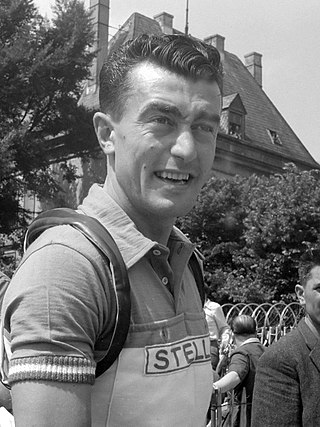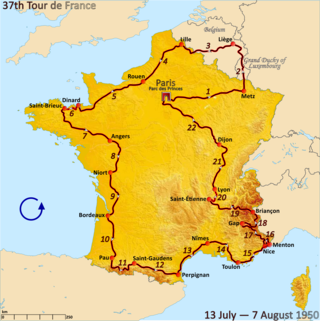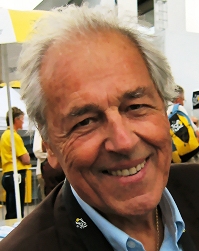
Louis "Louison" Bobet was a French professional road racing cyclist. He was the first great French rider of the post-war period and the first rider to win the Tour de France in three successive years, from 1953 to 1955. His career included the national road championship, Milan–San Remo (1951), Giro di Lombardia (1951), Critérium International, Paris–Nice (1952), Grand Prix des Nations (1952), world road championship (1954), Tour of Flanders (1955), Critérium du Dauphiné Libéré (1955), Tour de Luxembourg (1955), Paris–Roubaix (1956) and Bordeaux–Paris (1959).

Angelo Fausto Coppi was an Italian cyclist, the dominant international cyclist of the years after the Second World War. His successes earned him the title Il Campionissimo. He was an all-round racing cyclist: he excelled in both climbing and time trialing, and was also a good sprinter. He won the Giro d'Italia five times, the Tour de France twice, and the World Championship in 1953. Other notable results include winning the Giro di Lombardia five times, the Milan–San Remo three times, as well as wins at Paris–Roubaix and La Flèche Wallonne and setting the hour record (45.798 km) in 1942.

L'Équipe is a French nationwide daily newspaper devoted to sport, owned by Éditions Philippe Amaury. The paper is noted for coverage of association football, rugby, motorsport, and cycling. Its predecessor, L'Auto, was a general sports paper that also covered auto racing which was gaining popularity at the turn of the twentieth century.

Charly Gaul was a Luxembourgish professional cyclist. He was a national cyclo-cross champion, an accomplished time triallist and superb climber. His ability earned him the nickname of Angel of the Mountains in the 1958 Tour de France, which he won with four stage victories. He also won the Giro d'Italia in 1956 and 1959. Gaul rode best in cold, wet weather. In later life, he became a recluse and lost much of his memory.

Hugo Koblet was a Swiss champion cyclist. He won the Tour de France and the Giro d'Italia as well as competing in six-day and pursuit races on the track. He won 70 races as a professional. He died in a car accident amid speculation that he had committed suicide.

The 1952 Tour de France was the 39th edition of the Tour de France, taking place from 25 June to 19 July. It was composed of 23 stages over 4,898 km (3,043 mi). Newly introduced were the arrivals on mountain peaks.

The 1949 Tour de France was the 36th edition of the Tour de France, taking place from 30 June to 24 July. It consisted of 21 stages over 4,808 km (2,988 mi).

Jean Robic was a French road racing cyclist who won the 1947 Tour de France. Robic was a professional cyclist from 1943 to 1961. His diminutive stature and appearance was encapsulated in his nickname Biquet(Kid goat). For faster, gravity-assisted descents, he collected drinking bottles ballasted with lead or mercury at the summits of mountain climbs and "cols". After fracturing his skull in 1944 he always wore a trademark leather crash helmet.

The 1953 Tour de France was the 40th edition of the Tour de France, taking place from 3 to 26 July. It consisted of 22 stages over 4,476 km (2,781 mi).

The 1950 Tour de France was the 37th edition of the Tour de France, taking place from 13 July to 7 August. It consisted of 22 stages over 4,773 km (2,966 mi).

Raphaël Géminiani is a French former road bicycle racer. He had six podium finishes in the Grand Tours. He is one of four children of Italian immigrants who moved to Clermont-Ferrand fleeing from fascist violence. He worked in a cycle shop and started racing as a boy. He became a professional and then a directeur sportif, notably of Jacques Anquetil and the St-Raphaël team.
Jean Malléjac was a professional French road bicycle racer.
The Tour de France was not held during World War II because the organisers refused German requests. Although a 1940 Tour de France had been announced earlier, the outbreak of the war made it impossible for it to be held. After that, some attempts were made by the Germans during the war to have a Tour de France to maintain the sense of normality, but l'Auto, the organising newspaper, refused. Some other races were run as a replacement.
Pierre Chany was a French cycling journalist. He covered the Tour de France 49 times and was for a long time the main cycling writer for the daily newspaper, L'Équipe.
Albert Baker d'Isy was a French cycling journalist and author and the founder of the Grand Prix des Nations international time-trial. He is considered, in the French expression, "one of the most beautiful pens" of sports writing. Pierre Chany a contemporary, called him "The best sporting journalist of his generation."











